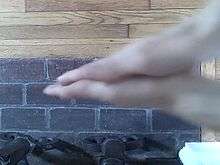Hand rubbing

Hand rubbing is a gesture that conveys in many cultures either that one has a feeling of excited expectation, or that one is simply cold.[1] In Ekman and Friesen's 1969 classification system for gestures, hand-rubbing as an indication of coldness is an emblem intentional gesture that could equally well be verbalized.[2]
Cultural differences
The gesture is widespread around the globe, although it is possibly more common in cultures of countries with colder climates than those with hotter climates. In South America, the gesture is used to imply that two women are lesbians.[3]
Hand rubbing involves rubbing the palms of one's hands together. As a gesture of expectation, the rate at which one rubs the palms together is significant. A fast pace indicates expectation of something good for onesself. But a slow pace indicates expectation of something bad for someone else. Context also affects the meaning of the gesture. In context, the meaning can vary from an indicator of internal (anticipatory) tension to meaning "Oh good!".[4][5]
The length of the gesture is also important. Rubbing one's hands together and then saying to another person (for example) that one expects to make money conveys to that person that they should be excited as well. Whereas rubbing one's hands together while saying the same thing conveys racism, and possibly the intention to deceive.[6][7]
In drama, rubbing hands can signify various things, such as a miser rubbing his palms together over money, Lady Macbeth washing the blood off her hands, a villain having just done a wicked deed, or a person simply anticipating a journey, a good meal, or meeting with a boyfriend/girlfriend.[8]
A psychological study of revenge by Robert Baron, a psychologist in the school of management at Rensselaer Polytechnic Institute, found that some people who had waited years to get even with others, plotting and waiting for the opportunity to "torpedo their enemy's career", would rub their hands together at the memory, in the fashion of cartoon villains.[9][10]
John Bulwer calls Lady Macbeth's hand rubbing gesture Gestus #XI: Innocentiam Ostendo (Latin for "I display innocence"). He states that "[t]o imitate the posture of washing the hands by rubbing the back of one in the hollow of the other with a kind of detersive motion is a gesture sometimes used by those who would professe their innocency and declare they have no Hand in that foule business, not so much as by their manuall assent […] for the Hands naturally imply, as it were in Hieroglyphique, mens acts and operations; and that cleansing motion denotes the cleannesse of their actions.". This gesture is also associated with Pilate and with Shakespeare's other plays Julius Caesar (where Brutus' hand-washing gesture is turned from a profession of innocency into a signal of guilt) and Richard II.[11][12][13]
References
- ↑ Adrian Furnham (1999). Body Language at Work. CIPD Publishing. p. 22. ISBN 9780852927717.
- ↑ John Hayes (2002). Interpersonal Skills at Work. Routledge. p. 82. ISBN 9780415227766.
- ↑ Nancy Armstrong & Melissa Wagner (2003). "Hand Rub". Field Guide to Gestures. Quirk Books. pp. 158–159. ISBN 9781931686204.
- ↑ V.M. Sharma (2004). "Hand-and-Arm Gestures". Body Language. Pustak Mahal. p. 37. ISBN 9788122306354.
- ↑ M. H. Ford (2004). "Hand Jive". Personal Power. iUniverse. p. 113. ISBN 9780595325870.
- ↑ Steve Roberts (2007). "animation of acting—body language". Character Animation. Elsevier. p. 192. ISBN 9780240520544.
- ↑ Elizabeth Kuhnke (2007). "The hand rub: Good for you or good for me?". Body Language for Dummies. For Dummies. p. 146. ISBN 9780470512913.
- ↑ Michael Theodorou (1989). Ideas That Work in Drama. Nelson Thornes. p. 15. ISBN 9780748702251.
- ↑ Benedict Cary (2004-07-27). "Payback time why revenge tastes so sweet". New York Times. p. 2.
- ↑ Stephen Denning (2005). "Stories that Tame the Grapevine". In Georg Schreyögg; Jean Caussanel; Jochen Koch. Knowledge Management and Narratives. Erich Schmidt Verlag GmbH. p. 95. ISBN 9783503090297.
- ↑ Joseph R. Roach (1985). The Player's Passion. University of Delaware Press. pp. 37–38. ISBN 9780874132656.
- ↑ Michael Neill (2003). "'Amphitheaters in the Body': Playing with Hands on the Shakespearian Stage". In Stanley Wells. Shakespeare Survey. Cambridge University Press. pp. 35–36. ISBN 9780521523875.
- ↑ Katherine Rowe (2003). "Minds in Company: Shakespearian Tragic Emotions". In Richard Dutton; Jean Elizabeth Howard. A Companion to Shakespeare's Works. Blackwell Publishing. pp. 56–57. ISBN 9780631226321.
Further reading
- Larry Engler & Carol Fijian (1996). "Rubbing Hands". Making Puppets Come Alive. Courier Dover Publications. p. 42. ISBN 9780486293783.